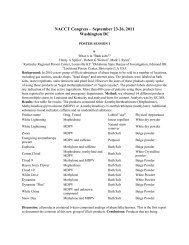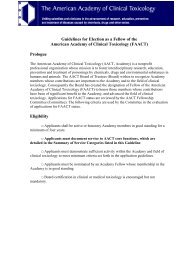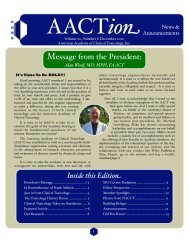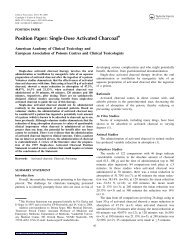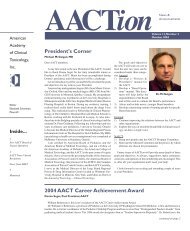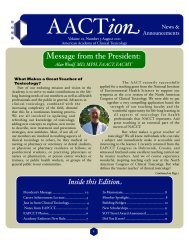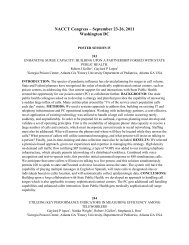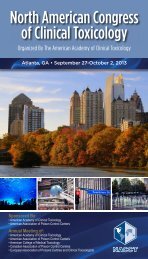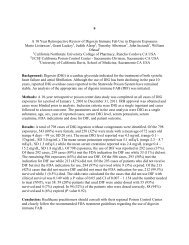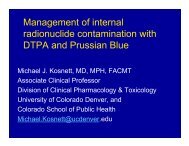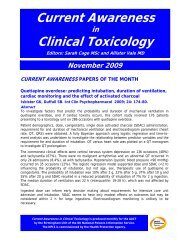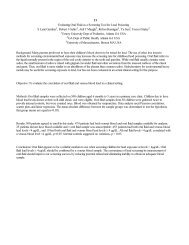NACCT Platform Abstracts 2012 - The American Academy of Clinical ...
NACCT Platform Abstracts 2012 - The American Academy of Clinical ...
NACCT Platform Abstracts 2012 - The American Academy of Clinical ...
You also want an ePaper? Increase the reach of your titles
YUMPU automatically turns print PDFs into web optimized ePapers that Google loves.
236<br />
Surveillance for Radiation Exposures Using the National Poison Data System<br />
Arthur Chang 1 , Royal Law 1 , Colleen Martin 1 , Alvin Bronstein 2 , Kendra Grande 3 , Karen Simone 4 , Martin Caravati 5 , Joshua<br />
Schier 1<br />
1 Centers for Disease Control and Prevention, Atlanta GA USA<br />
2 Rocky Mountain Poison and Drug Center, Denver CO USA<br />
3 Thomson Reuters, Denver CO USA<br />
4 Northern New England Poison Center, Portland ME USA<br />
5 Utah Poison Control Center, Salt Lake City UT USA<br />
Background: Since 2010, the Centers for Disease Control and Prevention (CDC) and the <strong>American</strong> Association <strong>of</strong> Poison<br />
Control Centers (AAPCC) have conducted surveillance for exposures to radiation and radioactive materials reported from all<br />
57 US Poison Centers (PCs) using the National Poison Data System (NPDS). CDC, AAPCC and Poisindex® Thomson<br />
Reuters, recently implemented improvements to the NPDS radiation coding structure to enhance its utility for public health<br />
surveillance. Our objective is to describe results from this surveillance and associated radiation incidents during a one-year<br />
period.<br />
Methods: We analyzed all PC calls from September 1, 2010 to September 1, 2011 that met our case definition: human<br />
exposure calls with any <strong>of</strong> the following NPDS codes: “miscellaneous non-radiopharmaceutical isotopes”, “miscellaneous<br />
radiopharmaceuticals”, or “ionizing radiation”. Exclusion criteria were: exposure calls about substances such as “radon”,<br />
“radon gas”, “non-ionizing radiation”, “smoke detectors” or calls with outcomes <strong>of</strong> “confirmed non-exposure” or “adverse<br />
reaction”. Using NPDS data, CDC staff reviewed each call meeting this definition. CDC and AAPCC staff also contacted the<br />
regional PC to obtain further information and confirm exposures. When multiple reported exposures clustered in space and<br />
time were detected, news stories in the public media were also monitored for associated radiation incidents.<br />
Results: During the study period, a total <strong>of</strong> 186 calls met the case definition. 51 <strong>of</strong> these were associated with 3 radiological<br />
incidents reported in the public media and one anti-terrorism exercise. <strong>The</strong> incidents included a radiation exposure from<br />
industrial radiography which led to the temporary closure <strong>of</strong> a hospital (n=4; 8%), a transportation accident involving potential<br />
radioactive contamination to several medical personnel (n=11; 22%), the Fukushima Daiichi Japan nuclear reactor disaster<br />
(n=10; 20%) and a regional radiation anti-terrorism exercise involving a cesium radiological dispersal device (n=26; 50%).<br />
<strong>The</strong> remaining 135 calls were single person exposures and were not followed by the regional PC.<br />
Conclusion: During a one-year period, our case definition detected 51 calls associated with four radiation incidents. <strong>The</strong>se<br />
incidents were <strong>of</strong> potential public health significance because they involved multiple persons and had the potential to cause<br />
widespread public concern. Similar surveillance strategies for detecting and tracking future radiological incidents using NPDS<br />
may be helpful to regional PCs and their public health partners.



